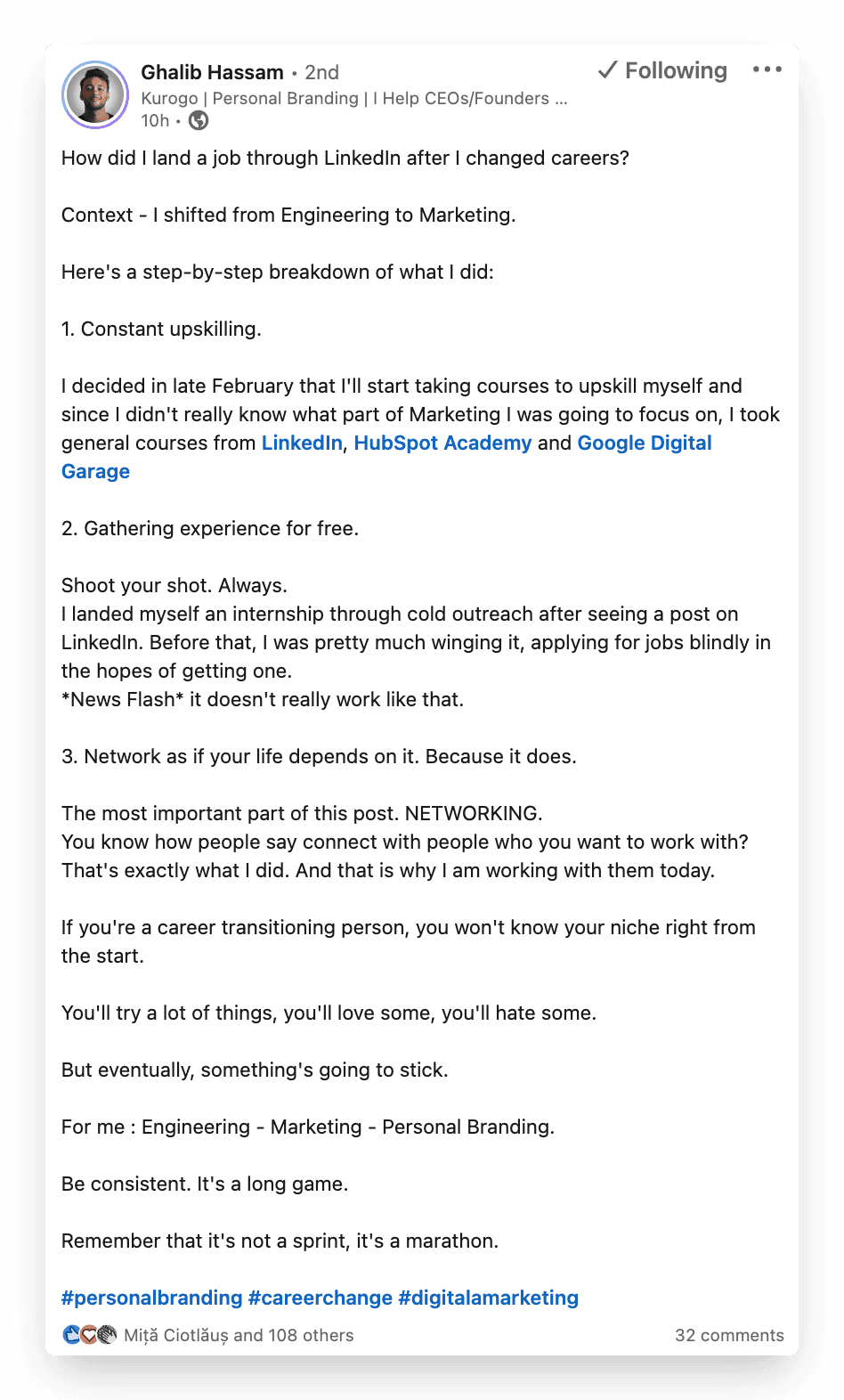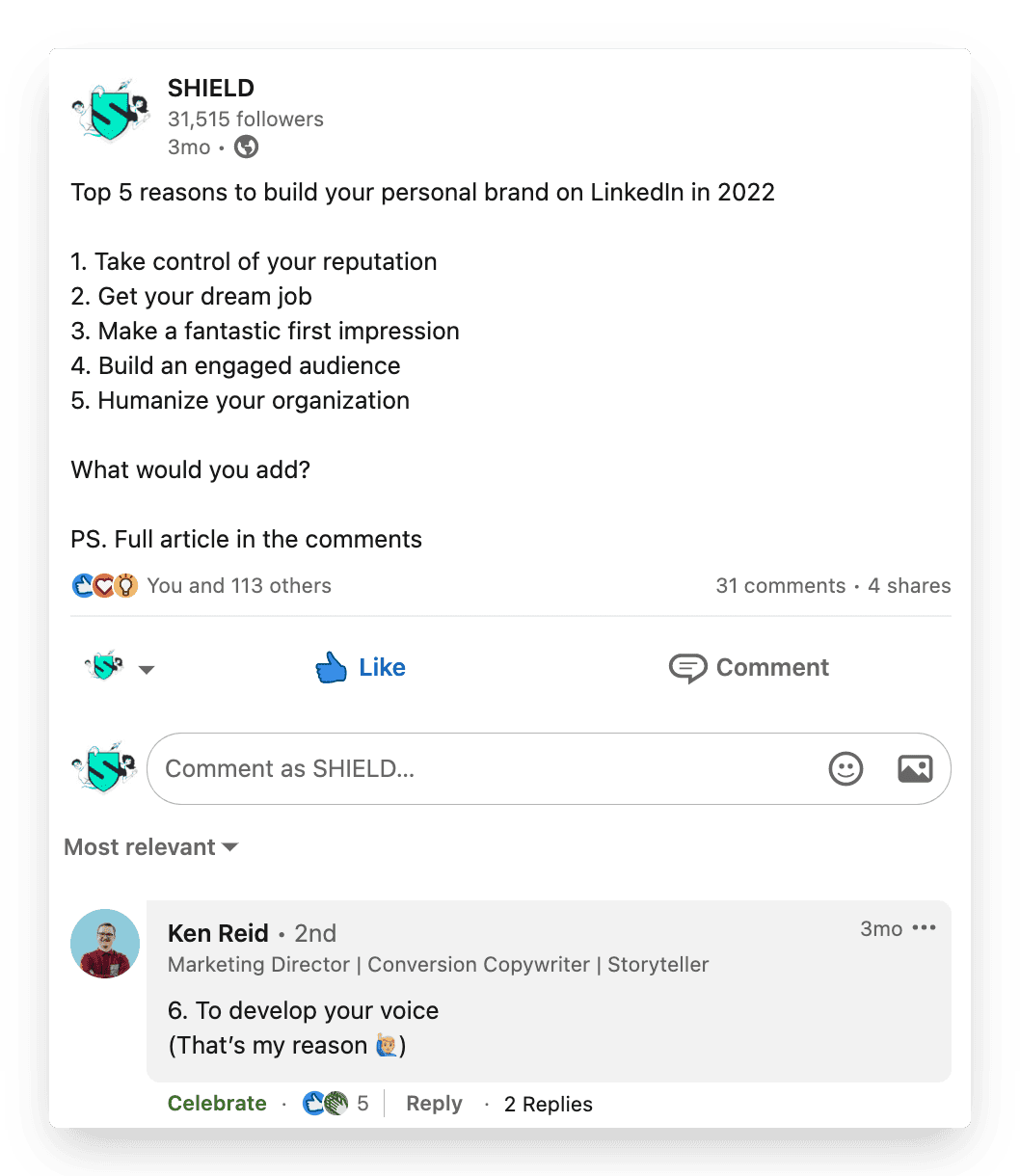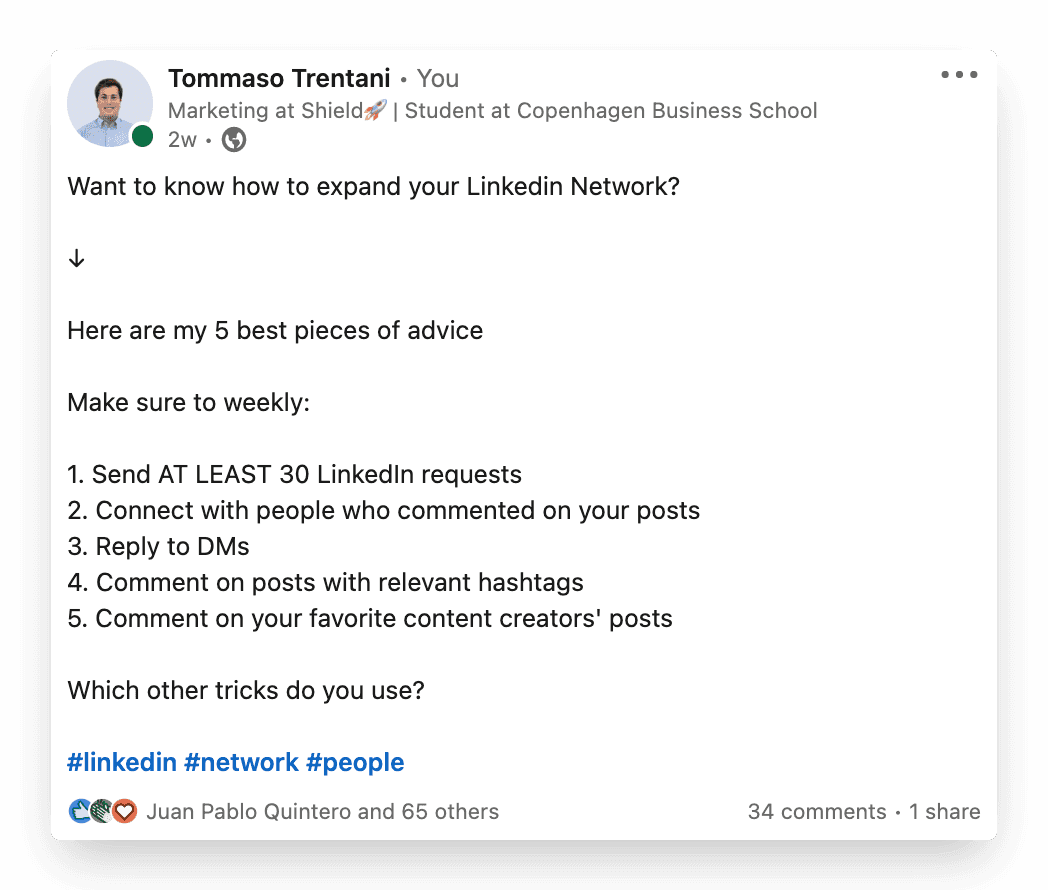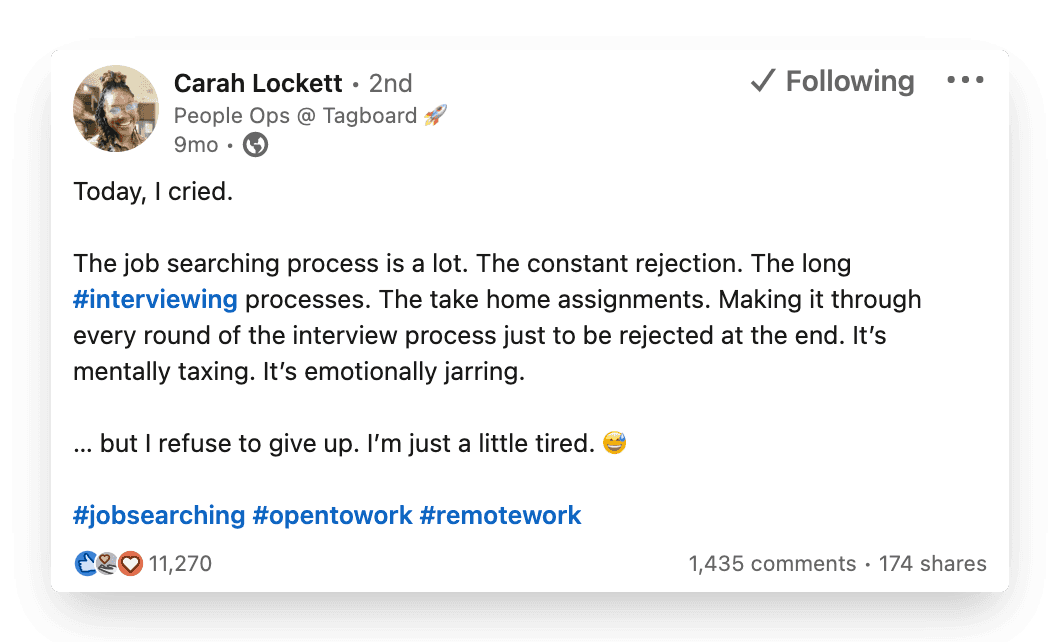How to find a job on LinkedIn with Personal Branding




Are you looking for your next dream job? Then we've got you covered. In this blog we are going to break down how you can use LinkedIn to stand out from the crowd and make your profile stand out in the job application process.
But here's the thing, it's not going to happen just by pressing that “Easy Apply" button. There are hundreds of others doing the same. To stand out you need to be strategic with your use of LinkedIn.
Let's dive into 7 ways you can make the job hunting process easier. From creating a plan, posting relevant content and focusing on targeted engagement, we’ll be covering all the ways you can get that dream job in 2022.
1. List companies you would love to work for
The first step to any successful job application: figure out where you want to work. If you’re just starting out, chances are you haven’t had a chance to figure out what you want and what you don’t want in a work environment. For you, the easiest route is to simply create a list of companies that you’d love to work for based on your aspirations and interests.
Don’t let the size of the company put you off either – someone has to work at Google, so why can’t it be you? If you’re a little more experienced, and you’re looking for a career change, follow the same as the above. Only, as you probably have a better idea of your likes and dislikes.
2. Prioritize based on the career path and fit
This leads us neatly to a question all job-seekers should ask themselves: where do I want to be in five years?
Applying at a company with minimal progression routes, nor a focus on training and development may affect your career prospects in the long term. By the time you leave any role, you should have at least matured your skillset.
One great litmus test is to see whether you have any LinkedIn connections that work at the company you’re applying to. How long have they been at the organization? What do they say about their role on their LinkedIn profile?
Both are good indicators of employee satisfaction.
3. Connect with the main decision-makers
Another way to assess whether or not a company might be the right fit for you is by connecting with some of its key decision-makers.
For example, if you’re applying to Company A, why not send a connection request to the hiring manager?
For a more direct approach, you can DM said key decision-maker and start the conversation, asking directly: what sort of qualities are they looking for from new hires? What skills do you need to demonstrate? Are there any pointers they can offer for the application process?
At best, you receive a ton of useful information that will aid your application. At worst, you’ll be showing initiative and, more often than not, the person you interact with will take note of this.
For a less direct approach, you can keep an eye on said decision-makers’ feed. You’ll gain a better understanding of their work culture, expectations, and ethos as a whole.
Point #3 on Ghalib’s post below illustrates this point nicely. For the full post, click here.

4. Engage with the decision-makers' posts
Jumping off from our third point, it’s not enough to simply follow key decision-makers. If you want to stand out from the crowd, you should be actively engaging with the content they produce.
Just to clarify: this does not mean a simple like, emoji, or three words comment. Although this is certainly a part of the LinkedIn engagement, you should be putting thought into how you react to their content. Additional time spent here will reap the rewards
For example, if Person X is writing about key marketing trends, be sure to comment reactively to their post. Comment on your experiences, whether you agree or disagree etc as it demonstrates a genuine interest in the topic they are writing about, and - perhaps more importantly - it gives you a voice.
Now, when you apply for a role at their company through LinkedIn, the chances are they’ll recognize you. And, as your content interactions become visible in their feed, you’ll be viewed by more of their connections - many of whom more than likely will work in the same industry.
Take a look at this example of active engagement from one of our posts below:

5. Reach out to common connections and DM
So we’ve talked about keeping an eye on any shared connections and their profiles. Fantastic - sometimes this is more than enough. And sometimes it isn’t.
If you’re still looking for more insights, why not DM them too?
Chances are, you’ll get a more employee-first response than you would from a key decision-maker within a company anyhow.
6. Ask them to chat with a clear CTA
“I look forward to hearing from you.”
Let’s be honest, we’ve all used this line once or twice. And while it definitely has its place, it just isn’t that memorable. So here’s an alternative:
End your email or message with excitement. Managers want to onboard people who are invested in their company’s mission, so be sure to show it. And, perhaps most importantly, take the next steps into your own hands by ending with a call to action.
For example:
“I am confident that my marketing experience will help your organization’s digital presence grow, similar to how I have increased follow growth for my company’s core socials platforms by 300% over the past year. If possible, I would like to discuss my background, relevant experience, and the reasons why I am great fit for this role with you in an interview at your earliest convenience. Please find my contact details below.”
7. Post content on LinkedIn
Speaking about honing your voice, be sure to post content on LinkedIn regularly. Posts don’t have to be overly text-heavy - see our guide on how to write a scroll-stopping post if you need any pointers - and they don’t need to be written by “industry experts”.
Posts can be polls, asking questions geared towards people with more industry knowledge. Posts can detail your own journey so far in your career. Posts can be a lot of things.
Even if you’ve just been invited to an interview, your experiences as to how you got invited to said interview are valuable to someone at the beginning of the application process.
So, how does this link to finding a job?
The more connections you make and the more interactions you have with people within your chosen industry, the more likely it is that you’ll catch the eye of recruiters.
Let’s put it this way:
A recruiter has two candidates in front of them. The first candidate will post on LinkedIn occasionally, but more often than not steers clear of posting their opinions. They send the same cookie-cutter CV, with a few tweaks, for every role they apply for.
The second candidate uses the platform to demonstrate engagement with their chosen field, posting regularly and becoming actively involved in pertinent discussions about their industry as a whole. Their CV is complemented by a personal brand that reflects their investment and know-how.
Which candidate sounds more appealing to the recruiter?
Here’s a great post example from Tommaso:

8. Posts that lead to a job
From time to time, reaching out to your LinkedIn audience for help and support can pay dividends too. Last year, Carah Locket posted about her frustrations during the job searching process.
As a result of her openness, her post started to gain traction. A lot of traction. Her comments section was flooded with words of encouragement and a number of high-profile employers started reaching out to her with employment opportunities.
Her post went so unexpectedly viral that she was featured in a Forbes article the following week and, within around a month, she happily said ‘yes’ to a job offer at Tagboard.

The moral here: if you’re looking for work, you can reach out to the LinkedIn community directly. At the worst, your connections may engage and send words of encouragement. And, in the best-case, you may have a few job recommendations sent your way.
This seems like a win-win any way you cut it.
9. Follow up
So you’ve written to the manager, but as of yet have had no response. Don’t give up yet – it’s entirely possible that your message or email has been buried in the slew of correspondence they receive on a daily basis.
Even if they weren’t interested in hiring you, it’s common courtesy to send a response email.
The only exception to this would be for roles that specify that no response within a certain time frame equates to an unsuccessful application.
If the above wasn’t stated, however, your next step can be to send a follow-up - either via phone call or email.
Of course, wait an appropriate amount of time before proceeding with this. Managers don’t want to be bombarded with emails and phone calls in quick succession!
To conclude…
Hopefully, by now you’ve got a few pointers to get you started with your job hunt on LinkedIn using your personal brand. Let’s take a quick recap of what we’ve covered:
Listing the companies you would love to work for
Prioritizing applications based on the career path and fit
Connecting with the main decision-makers
Engaging with the decision-makers' posts
Reaching out to common connections
Asking the manager for a chat with a clear CTA
Posting content on LinkedIn
Posts that lead to a job
Following up
And that’s all for now! If you’re struggling with building your personal brand, be sure to check out our guide on how to get noticed on LinkedIn.
Are you looking for your next dream job? Then we've got you covered. In this blog we are going to break down how you can use LinkedIn to stand out from the crowd and make your profile stand out in the job application process.
But here's the thing, it's not going to happen just by pressing that “Easy Apply" button. There are hundreds of others doing the same. To stand out you need to be strategic with your use of LinkedIn.
Let's dive into 7 ways you can make the job hunting process easier. From creating a plan, posting relevant content and focusing on targeted engagement, we’ll be covering all the ways you can get that dream job in 2022.
1. List companies you would love to work for
The first step to any successful job application: figure out where you want to work. If you’re just starting out, chances are you haven’t had a chance to figure out what you want and what you don’t want in a work environment. For you, the easiest route is to simply create a list of companies that you’d love to work for based on your aspirations and interests.
Don’t let the size of the company put you off either – someone has to work at Google, so why can’t it be you? If you’re a little more experienced, and you’re looking for a career change, follow the same as the above. Only, as you probably have a better idea of your likes and dislikes.
2. Prioritize based on the career path and fit
This leads us neatly to a question all job-seekers should ask themselves: where do I want to be in five years?
Applying at a company with minimal progression routes, nor a focus on training and development may affect your career prospects in the long term. By the time you leave any role, you should have at least matured your skillset.
One great litmus test is to see whether you have any LinkedIn connections that work at the company you’re applying to. How long have they been at the organization? What do they say about their role on their LinkedIn profile?
Both are good indicators of employee satisfaction.
3. Connect with the main decision-makers
Another way to assess whether or not a company might be the right fit for you is by connecting with some of its key decision-makers.
For example, if you’re applying to Company A, why not send a connection request to the hiring manager?
For a more direct approach, you can DM said key decision-maker and start the conversation, asking directly: what sort of qualities are they looking for from new hires? What skills do you need to demonstrate? Are there any pointers they can offer for the application process?
At best, you receive a ton of useful information that will aid your application. At worst, you’ll be showing initiative and, more often than not, the person you interact with will take note of this.
For a less direct approach, you can keep an eye on said decision-makers’ feed. You’ll gain a better understanding of their work culture, expectations, and ethos as a whole.
Point #3 on Ghalib’s post below illustrates this point nicely. For the full post, click here.

4. Engage with the decision-makers' posts
Jumping off from our third point, it’s not enough to simply follow key decision-makers. If you want to stand out from the crowd, you should be actively engaging with the content they produce.
Just to clarify: this does not mean a simple like, emoji, or three words comment. Although this is certainly a part of the LinkedIn engagement, you should be putting thought into how you react to their content. Additional time spent here will reap the rewards
For example, if Person X is writing about key marketing trends, be sure to comment reactively to their post. Comment on your experiences, whether you agree or disagree etc as it demonstrates a genuine interest in the topic they are writing about, and - perhaps more importantly - it gives you a voice.
Now, when you apply for a role at their company through LinkedIn, the chances are they’ll recognize you. And, as your content interactions become visible in their feed, you’ll be viewed by more of their connections - many of whom more than likely will work in the same industry.
Take a look at this example of active engagement from one of our posts below:

5. Reach out to common connections and DM
So we’ve talked about keeping an eye on any shared connections and their profiles. Fantastic - sometimes this is more than enough. And sometimes it isn’t.
If you’re still looking for more insights, why not DM them too?
Chances are, you’ll get a more employee-first response than you would from a key decision-maker within a company anyhow.
6. Ask them to chat with a clear CTA
“I look forward to hearing from you.”
Let’s be honest, we’ve all used this line once or twice. And while it definitely has its place, it just isn’t that memorable. So here’s an alternative:
End your email or message with excitement. Managers want to onboard people who are invested in their company’s mission, so be sure to show it. And, perhaps most importantly, take the next steps into your own hands by ending with a call to action.
For example:
“I am confident that my marketing experience will help your organization’s digital presence grow, similar to how I have increased follow growth for my company’s core socials platforms by 300% over the past year. If possible, I would like to discuss my background, relevant experience, and the reasons why I am great fit for this role with you in an interview at your earliest convenience. Please find my contact details below.”
7. Post content on LinkedIn
Speaking about honing your voice, be sure to post content on LinkedIn regularly. Posts don’t have to be overly text-heavy - see our guide on how to write a scroll-stopping post if you need any pointers - and they don’t need to be written by “industry experts”.
Posts can be polls, asking questions geared towards people with more industry knowledge. Posts can detail your own journey so far in your career. Posts can be a lot of things.
Even if you’ve just been invited to an interview, your experiences as to how you got invited to said interview are valuable to someone at the beginning of the application process.
So, how does this link to finding a job?
The more connections you make and the more interactions you have with people within your chosen industry, the more likely it is that you’ll catch the eye of recruiters.
Let’s put it this way:
A recruiter has two candidates in front of them. The first candidate will post on LinkedIn occasionally, but more often than not steers clear of posting their opinions. They send the same cookie-cutter CV, with a few tweaks, for every role they apply for.
The second candidate uses the platform to demonstrate engagement with their chosen field, posting regularly and becoming actively involved in pertinent discussions about their industry as a whole. Their CV is complemented by a personal brand that reflects their investment and know-how.
Which candidate sounds more appealing to the recruiter?
Here’s a great post example from Tommaso:

8. Posts that lead to a job
From time to time, reaching out to your LinkedIn audience for help and support can pay dividends too. Last year, Carah Locket posted about her frustrations during the job searching process.
As a result of her openness, her post started to gain traction. A lot of traction. Her comments section was flooded with words of encouragement and a number of high-profile employers started reaching out to her with employment opportunities.
Her post went so unexpectedly viral that she was featured in a Forbes article the following week and, within around a month, she happily said ‘yes’ to a job offer at Tagboard.

The moral here: if you’re looking for work, you can reach out to the LinkedIn community directly. At the worst, your connections may engage and send words of encouragement. And, in the best-case, you may have a few job recommendations sent your way.
This seems like a win-win any way you cut it.
9. Follow up
So you’ve written to the manager, but as of yet have had no response. Don’t give up yet – it’s entirely possible that your message or email has been buried in the slew of correspondence they receive on a daily basis.
Even if they weren’t interested in hiring you, it’s common courtesy to send a response email.
The only exception to this would be for roles that specify that no response within a certain time frame equates to an unsuccessful application.
If the above wasn’t stated, however, your next step can be to send a follow-up - either via phone call or email.
Of course, wait an appropriate amount of time before proceeding with this. Managers don’t want to be bombarded with emails and phone calls in quick succession!
To conclude…
Hopefully, by now you’ve got a few pointers to get you started with your job hunt on LinkedIn using your personal brand. Let’s take a quick recap of what we’ve covered:
Listing the companies you would love to work for
Prioritizing applications based on the career path and fit
Connecting with the main decision-makers
Engaging with the decision-makers' posts
Reaching out to common connections
Asking the manager for a chat with a clear CTA
Posting content on LinkedIn
Posts that lead to a job
Following up
And that’s all for now! If you’re struggling with building your personal brand, be sure to check out our guide on how to get noticed on LinkedIn.
Are you looking for your next dream job? Then we've got you covered. In this blog we are going to break down how you can use LinkedIn to stand out from the crowd and make your profile stand out in the job application process.
But here's the thing, it's not going to happen just by pressing that “Easy Apply" button. There are hundreds of others doing the same. To stand out you need to be strategic with your use of LinkedIn.
Let's dive into 7 ways you can make the job hunting process easier. From creating a plan, posting relevant content and focusing on targeted engagement, we’ll be covering all the ways you can get that dream job in 2022.
1. List companies you would love to work for
The first step to any successful job application: figure out where you want to work. If you’re just starting out, chances are you haven’t had a chance to figure out what you want and what you don’t want in a work environment. For you, the easiest route is to simply create a list of companies that you’d love to work for based on your aspirations and interests.
Don’t let the size of the company put you off either – someone has to work at Google, so why can’t it be you? If you’re a little more experienced, and you’re looking for a career change, follow the same as the above. Only, as you probably have a better idea of your likes and dislikes.
2. Prioritize based on the career path and fit
This leads us neatly to a question all job-seekers should ask themselves: where do I want to be in five years?
Applying at a company with minimal progression routes, nor a focus on training and development may affect your career prospects in the long term. By the time you leave any role, you should have at least matured your skillset.
One great litmus test is to see whether you have any LinkedIn connections that work at the company you’re applying to. How long have they been at the organization? What do they say about their role on their LinkedIn profile?
Both are good indicators of employee satisfaction.
3. Connect with the main decision-makers
Another way to assess whether or not a company might be the right fit for you is by connecting with some of its key decision-makers.
For example, if you’re applying to Company A, why not send a connection request to the hiring manager?
For a more direct approach, you can DM said key decision-maker and start the conversation, asking directly: what sort of qualities are they looking for from new hires? What skills do you need to demonstrate? Are there any pointers they can offer for the application process?
At best, you receive a ton of useful information that will aid your application. At worst, you’ll be showing initiative and, more often than not, the person you interact with will take note of this.
For a less direct approach, you can keep an eye on said decision-makers’ feed. You’ll gain a better understanding of their work culture, expectations, and ethos as a whole.
Point #3 on Ghalib’s post below illustrates this point nicely. For the full post, click here.

4. Engage with the decision-makers' posts
Jumping off from our third point, it’s not enough to simply follow key decision-makers. If you want to stand out from the crowd, you should be actively engaging with the content they produce.
Just to clarify: this does not mean a simple like, emoji, or three words comment. Although this is certainly a part of the LinkedIn engagement, you should be putting thought into how you react to their content. Additional time spent here will reap the rewards
For example, if Person X is writing about key marketing trends, be sure to comment reactively to their post. Comment on your experiences, whether you agree or disagree etc as it demonstrates a genuine interest in the topic they are writing about, and - perhaps more importantly - it gives you a voice.
Now, when you apply for a role at their company through LinkedIn, the chances are they’ll recognize you. And, as your content interactions become visible in their feed, you’ll be viewed by more of their connections - many of whom more than likely will work in the same industry.
Take a look at this example of active engagement from one of our posts below:

5. Reach out to common connections and DM
So we’ve talked about keeping an eye on any shared connections and their profiles. Fantastic - sometimes this is more than enough. And sometimes it isn’t.
If you’re still looking for more insights, why not DM them too?
Chances are, you’ll get a more employee-first response than you would from a key decision-maker within a company anyhow.
6. Ask them to chat with a clear CTA
“I look forward to hearing from you.”
Let’s be honest, we’ve all used this line once or twice. And while it definitely has its place, it just isn’t that memorable. So here’s an alternative:
End your email or message with excitement. Managers want to onboard people who are invested in their company’s mission, so be sure to show it. And, perhaps most importantly, take the next steps into your own hands by ending with a call to action.
For example:
“I am confident that my marketing experience will help your organization’s digital presence grow, similar to how I have increased follow growth for my company’s core socials platforms by 300% over the past year. If possible, I would like to discuss my background, relevant experience, and the reasons why I am great fit for this role with you in an interview at your earliest convenience. Please find my contact details below.”
7. Post content on LinkedIn
Speaking about honing your voice, be sure to post content on LinkedIn regularly. Posts don’t have to be overly text-heavy - see our guide on how to write a scroll-stopping post if you need any pointers - and they don’t need to be written by “industry experts”.
Posts can be polls, asking questions geared towards people with more industry knowledge. Posts can detail your own journey so far in your career. Posts can be a lot of things.
Even if you’ve just been invited to an interview, your experiences as to how you got invited to said interview are valuable to someone at the beginning of the application process.
So, how does this link to finding a job?
The more connections you make and the more interactions you have with people within your chosen industry, the more likely it is that you’ll catch the eye of recruiters.
Let’s put it this way:
A recruiter has two candidates in front of them. The first candidate will post on LinkedIn occasionally, but more often than not steers clear of posting their opinions. They send the same cookie-cutter CV, with a few tweaks, for every role they apply for.
The second candidate uses the platform to demonstrate engagement with their chosen field, posting regularly and becoming actively involved in pertinent discussions about their industry as a whole. Their CV is complemented by a personal brand that reflects their investment and know-how.
Which candidate sounds more appealing to the recruiter?
Here’s a great post example from Tommaso:

8. Posts that lead to a job
From time to time, reaching out to your LinkedIn audience for help and support can pay dividends too. Last year, Carah Locket posted about her frustrations during the job searching process.
As a result of her openness, her post started to gain traction. A lot of traction. Her comments section was flooded with words of encouragement and a number of high-profile employers started reaching out to her with employment opportunities.
Her post went so unexpectedly viral that she was featured in a Forbes article the following week and, within around a month, she happily said ‘yes’ to a job offer at Tagboard.

The moral here: if you’re looking for work, you can reach out to the LinkedIn community directly. At the worst, your connections may engage and send words of encouragement. And, in the best-case, you may have a few job recommendations sent your way.
This seems like a win-win any way you cut it.
9. Follow up
So you’ve written to the manager, but as of yet have had no response. Don’t give up yet – it’s entirely possible that your message or email has been buried in the slew of correspondence they receive on a daily basis.
Even if they weren’t interested in hiring you, it’s common courtesy to send a response email.
The only exception to this would be for roles that specify that no response within a certain time frame equates to an unsuccessful application.
If the above wasn’t stated, however, your next step can be to send a follow-up - either via phone call or email.
Of course, wait an appropriate amount of time before proceeding with this. Managers don’t want to be bombarded with emails and phone calls in quick succession!
To conclude…
Hopefully, by now you’ve got a few pointers to get you started with your job hunt on LinkedIn using your personal brand. Let’s take a quick recap of what we’ve covered:
Listing the companies you would love to work for
Prioritizing applications based on the career path and fit
Connecting with the main decision-makers
Engaging with the decision-makers' posts
Reaching out to common connections
Asking the manager for a chat with a clear CTA
Posting content on LinkedIn
Posts that lead to a job
Following up
And that’s all for now! If you’re struggling with building your personal brand, be sure to check out our guide on how to get noticed on LinkedIn.
Are you looking for your next dream job? Then we've got you covered. In this blog we are going to break down how you can use LinkedIn to stand out from the crowd and make your profile stand out in the job application process.
But here's the thing, it's not going to happen just by pressing that “Easy Apply" button. There are hundreds of others doing the same. To stand out you need to be strategic with your use of LinkedIn.
Let's dive into 7 ways you can make the job hunting process easier. From creating a plan, posting relevant content and focusing on targeted engagement, we’ll be covering all the ways you can get that dream job in 2022.
1. List companies you would love to work for
The first step to any successful job application: figure out where you want to work. If you’re just starting out, chances are you haven’t had a chance to figure out what you want and what you don’t want in a work environment. For you, the easiest route is to simply create a list of companies that you’d love to work for based on your aspirations and interests.
Don’t let the size of the company put you off either – someone has to work at Google, so why can’t it be you? If you’re a little more experienced, and you’re looking for a career change, follow the same as the above. Only, as you probably have a better idea of your likes and dislikes.
2. Prioritize based on the career path and fit
This leads us neatly to a question all job-seekers should ask themselves: where do I want to be in five years?
Applying at a company with minimal progression routes, nor a focus on training and development may affect your career prospects in the long term. By the time you leave any role, you should have at least matured your skillset.
One great litmus test is to see whether you have any LinkedIn connections that work at the company you’re applying to. How long have they been at the organization? What do they say about their role on their LinkedIn profile?
Both are good indicators of employee satisfaction.
3. Connect with the main decision-makers
Another way to assess whether or not a company might be the right fit for you is by connecting with some of its key decision-makers.
For example, if you’re applying to Company A, why not send a connection request to the hiring manager?
For a more direct approach, you can DM said key decision-maker and start the conversation, asking directly: what sort of qualities are they looking for from new hires? What skills do you need to demonstrate? Are there any pointers they can offer for the application process?
At best, you receive a ton of useful information that will aid your application. At worst, you’ll be showing initiative and, more often than not, the person you interact with will take note of this.
For a less direct approach, you can keep an eye on said decision-makers’ feed. You’ll gain a better understanding of their work culture, expectations, and ethos as a whole.
Point #3 on Ghalib’s post below illustrates this point nicely. For the full post, click here.

4. Engage with the decision-makers' posts
Jumping off from our third point, it’s not enough to simply follow key decision-makers. If you want to stand out from the crowd, you should be actively engaging with the content they produce.
Just to clarify: this does not mean a simple like, emoji, or three words comment. Although this is certainly a part of the LinkedIn engagement, you should be putting thought into how you react to their content. Additional time spent here will reap the rewards
For example, if Person X is writing about key marketing trends, be sure to comment reactively to their post. Comment on your experiences, whether you agree or disagree etc as it demonstrates a genuine interest in the topic they are writing about, and - perhaps more importantly - it gives you a voice.
Now, when you apply for a role at their company through LinkedIn, the chances are they’ll recognize you. And, as your content interactions become visible in their feed, you’ll be viewed by more of their connections - many of whom more than likely will work in the same industry.
Take a look at this example of active engagement from one of our posts below:

5. Reach out to common connections and DM
So we’ve talked about keeping an eye on any shared connections and their profiles. Fantastic - sometimes this is more than enough. And sometimes it isn’t.
If you’re still looking for more insights, why not DM them too?
Chances are, you’ll get a more employee-first response than you would from a key decision-maker within a company anyhow.
6. Ask them to chat with a clear CTA
“I look forward to hearing from you.”
Let’s be honest, we’ve all used this line once or twice. And while it definitely has its place, it just isn’t that memorable. So here’s an alternative:
End your email or message with excitement. Managers want to onboard people who are invested in their company’s mission, so be sure to show it. And, perhaps most importantly, take the next steps into your own hands by ending with a call to action.
For example:
“I am confident that my marketing experience will help your organization’s digital presence grow, similar to how I have increased follow growth for my company’s core socials platforms by 300% over the past year. If possible, I would like to discuss my background, relevant experience, and the reasons why I am great fit for this role with you in an interview at your earliest convenience. Please find my contact details below.”
7. Post content on LinkedIn
Speaking about honing your voice, be sure to post content on LinkedIn regularly. Posts don’t have to be overly text-heavy - see our guide on how to write a scroll-stopping post if you need any pointers - and they don’t need to be written by “industry experts”.
Posts can be polls, asking questions geared towards people with more industry knowledge. Posts can detail your own journey so far in your career. Posts can be a lot of things.
Even if you’ve just been invited to an interview, your experiences as to how you got invited to said interview are valuable to someone at the beginning of the application process.
So, how does this link to finding a job?
The more connections you make and the more interactions you have with people within your chosen industry, the more likely it is that you’ll catch the eye of recruiters.
Let’s put it this way:
A recruiter has two candidates in front of them. The first candidate will post on LinkedIn occasionally, but more often than not steers clear of posting their opinions. They send the same cookie-cutter CV, with a few tweaks, for every role they apply for.
The second candidate uses the platform to demonstrate engagement with their chosen field, posting regularly and becoming actively involved in pertinent discussions about their industry as a whole. Their CV is complemented by a personal brand that reflects their investment and know-how.
Which candidate sounds more appealing to the recruiter?
Here’s a great post example from Tommaso:

8. Posts that lead to a job
From time to time, reaching out to your LinkedIn audience for help and support can pay dividends too. Last year, Carah Locket posted about her frustrations during the job searching process.
As a result of her openness, her post started to gain traction. A lot of traction. Her comments section was flooded with words of encouragement and a number of high-profile employers started reaching out to her with employment opportunities.
Her post went so unexpectedly viral that she was featured in a Forbes article the following week and, within around a month, she happily said ‘yes’ to a job offer at Tagboard.

The moral here: if you’re looking for work, you can reach out to the LinkedIn community directly. At the worst, your connections may engage and send words of encouragement. And, in the best-case, you may have a few job recommendations sent your way.
This seems like a win-win any way you cut it.
9. Follow up
So you’ve written to the manager, but as of yet have had no response. Don’t give up yet – it’s entirely possible that your message or email has been buried in the slew of correspondence they receive on a daily basis.
Even if they weren’t interested in hiring you, it’s common courtesy to send a response email.
The only exception to this would be for roles that specify that no response within a certain time frame equates to an unsuccessful application.
If the above wasn’t stated, however, your next step can be to send a follow-up - either via phone call or email.
Of course, wait an appropriate amount of time before proceeding with this. Managers don’t want to be bombarded with emails and phone calls in quick succession!
To conclude…
Hopefully, by now you’ve got a few pointers to get you started with your job hunt on LinkedIn using your personal brand. Let’s take a quick recap of what we’ve covered:
Listing the companies you would love to work for
Prioritizing applications based on the career path and fit
Connecting with the main decision-makers
Engaging with the decision-makers' posts
Reaching out to common connections
Asking the manager for a chat with a clear CTA
Posting content on LinkedIn
Posts that lead to a job
Following up
And that’s all for now! If you’re struggling with building your personal brand, be sure to check out our guide on how to get noticed on LinkedIn.


